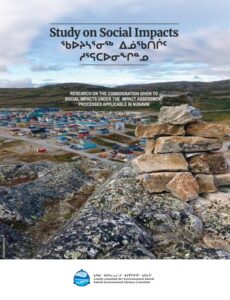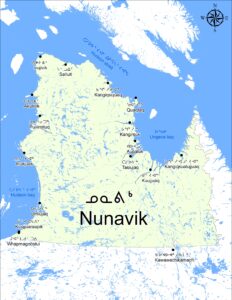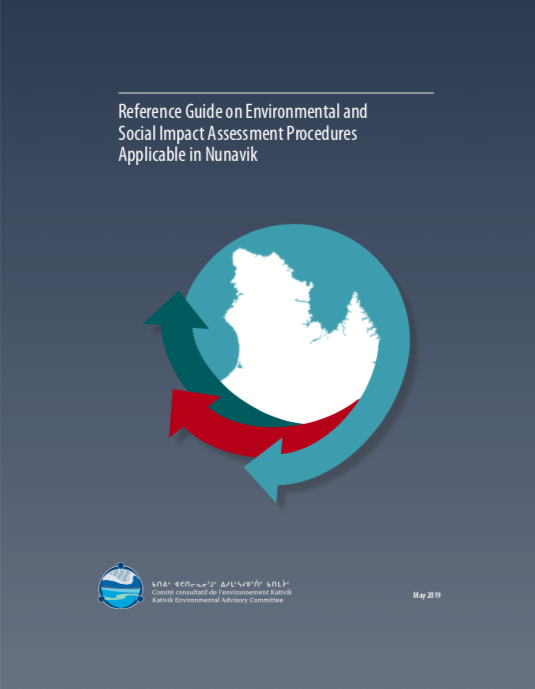Impact assessment in Nunavik
Introduction
The James Bay and Northern Quebec Agreement (JBNQA) was signed in 1975 by the governments of Canada and Québec, three provincial government corporations (Hydro-Québec, the James Bay Energy Corporation and the James Bay Development Corporation), the Grand Council of the Crees of Québec and the Northern Québec Inuit Association (now known as the Makivik Corporation). The JBNQA is the first modern treaty signed in Canada. In 1978, the Northeastern Québec Agreement (NEQA) was signed by the parties to the JBNQA as well as the Naskapis de Schefferville Band (now known as the Naskapi Nation of Kawawachikamach) in order to extend the regimes established under the JBNQA to Naskapi territory, including the environmental and social protection regime established in Section 23. The map below displays the territory covered by the JBNQA and the NEQA. It should be noted that Section 23 of the JBNQA applies to the Naskapi area of primary interest, which is situated predominantly north of the 55th parallel, even though Kawawachikamach is situated south of the 55th parallel.
Impact assessment is a development planning tool targeting sustainable use of resources and lands. Prior to the implementation of development projects, impact assessment examines and analyzes all the factors that influence ecosystems, resources and the quality of life of the concerned communities. Public information and consultation mechanisms ensure that it takes into account the values of individuals, groups and communities. Impact assessment aims to enhance development project designs while mitigating (or even eliminating) any negative impacts on the human and biophysical environments.
Pursuant to the legislation and regulations applicable in Nunavik, project proponents planning work that is likely to significantly modify the environment must prepare descriptions of their projects and their potential environmental and social impacts. Following analysis of this information, the responsible bodies decide on whether one or more authorizations are required and, if applicable, whether these will contain specific conditions.
Four Impact Assessment Procedures in Nunavik
In Nunavik, up to four impact assessment procedures may be applicable to development projects:
- The provincial procedure under the JBNQA;
- The federal procedure under the JBNQA;
- The federal procedure under the Impact Assessment Act;
- The procedure under the NILCA.
Given the complexity and diversity of the impact assessment procedures applicable in Nunavik, the KEAC feels it is important to strengthen understanding of them. It also encourages public participation in consultations during project assessments.
The KEAC developed the Reference Guide on Environmental and Social Impact Assessment Procedures Applicable in Nunavik. It clearly describes each of the four impact assessment procedures that can be applied to development projects in Nunavik, with particular focus on public participation. For each procedure, a short description, a flowchart and a detailed step-by-step chart are provided, as well as the contact information for the concerned review bodies.
Multiplication of Impact Assessment Procedures
The KEAC is concerned that, for some development projects in Nunavik, as many as four impact assessment procedures may be applicable. The KEAC monitors the implementation of these procedures by the responsible review bodies and, over the years, has prepared feedback on the topic:
- Letter – Environmental assessment applicable to the Hopes Advance iron mining project (February 2016)
- Position paper – Overlapping environmental assessment procedures in Nunavik (March 2002)
Consideration for Social Impacts

In 2017, the KEAC initiated an examination of the social impact assessment practices applied to development projects subject to any of the four environmental assessment processes applicable in Nunavik. The goal was to produce a comparative review of the scope of these practices under the processes, to identify the strengths and weaknesses of each process, and to prepare recommendations for authorities responsible for the application and implementation of the processes. To this end, the KEAC commissioned the Secrétariat international francophone pour l’évaluation environnementale (international francophone secretariat for environmental assessment, SIFÉE) to study how social impact assessment is carried out under the four environmental assessment processes applicable in Nunavik. This project lead to the creation of three documents: the full study, an easy-to-read summary and a presentation. Note that the results, recommendations and analyses contained in the current document are the author’s own work and not official KEAC recommendations.

